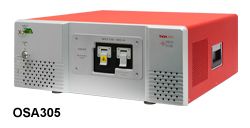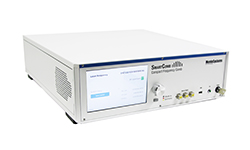wavemeters (original) (raw)
Definition: devices for precise measurements of laser wavelengths
Alternative term: wavelength meters
Categories:  photonic devices,
photonic devices,  light detection and characterization,
light detection and characterization,  optical metrology
optical metrology
- optical metrology instruments
- autocollimators
- beam profilers
- colorimeters
- colorimetry
- frequency metrology
- laser beam characterization
- optical energy meters
- optical frequency standards
- optical power meters
- optical power monitors
- optical profilometers
- optical spectrum analyzers
- optical time-domain reflectometers
- powermeters
- photometry
- polarimeters
- refractometers
- spectrographs
- spectrometers
- spectrophotometers
- wavemeters
- (more topics)
Related: Michelson interferometersspectrometersfrequency metrologylaser spectroscopy
Page views in 12 months: 3318
DOI: 10.61835/8qw Cite the article: BibTex BibLaTex plain textHTML Link to this page! LinkedIn
Content quality and neutrality are maintained according to our editorial policy.
📦 For purchasing wavemeters, use the RP Photonics Buyer's Guide — an expert-curated directory for finding all relevant suppliers, which also offers advanced purchasing assistance.
Contents
What are Wavemeters?
A wavemeter (or wavelength meter) is a kind of interferometer which is used for precise wavelength measurements for light which is delivered in the form of a laser beam. There are different variants, including scanning wavemeters and static devices with no moving parts.
Scanning Michelson Interferometer

Figure 1: Scanning Michelson wavemeter.
An often used type of wavemeter is based on a Michelson interferometer. Figure 1 shows the principle setup. Light from the optical source under test is sent into the Michelson interferometer, while the length of one of interferometer arms is scanned through a certain range. The period of the output power recorded by the photodetector with respect to the arm length changes then reflects the wavelength. The control of the measurement process and the data analysis are usually accomplished with a microprocessor device.
The principle of such a wavemeter can be extended for the measurement of the optical spectrum of non-monochromatic (= polychromatic) sources (→ spectrometers). Essentially, the spectrum is obtained by applying a Fourier transform to the detected power versus arm length difference. This method is called Fourier transform spectroscopy.
Various types of errors can affect the measurement accuracy:
- Length drifts (caused by temperature drifts, for example) and imperfections of the scanning mechanism can introduce substantial errors. Such errors can be largely removed by simultaneously recording the signal from a stabilized reference laser with known wavelength.
- Imperfections or changes in the beam profile can affect the results. Therefore, the input light is usually spatially filtered before its gets into the interferometer. Ideal filtering is achieved when the light is supplied through a single-mode fiber. For spatially multimode inputs, one may use a kind of mode cleaner, consisting of a pinhole between two lenses, for example.
- The accuracy of determining the oscillation period of the signal is limited by the width of the scanning range.
- For high-accuracy devices, various other effects can be relevant. For example, the results can be affected by fluctuations in the optical input power and by detector noise.
Depending on the quality of the device, the achieved wavelength accuracy can be 0.01 nm, for example. Due to the scanning, such devices are not suitable for pulsed radiation.
Static Fizeau Interferometer

Figure 2: Static wavemeter based on a Fizeau interferometer.
A Fizeau interferometer (Figure 2) uses two plane reflecting surfaces with a slight deviation from exact parallelity. For example, it can contain a glass wedge with a small angular mismatch of a few arcseconds, for example, where the front surface is partially reflecting and the back surface is fully reflecting. There are also implementations with discrete mirrors.
Effectively, two copies of the input beam are superimposed with a slight relative angle, leading to an interference pattern, the period of which depends on the wavelength. Usually, the input beam first gets through some spatial filter, and a collimated beam with large diameter is sent onto the Fizeau interferometer.
The shape of the interference pattern is measured with a CCD array, for example, and the data are processed using a microprocessor.
This technique does not require moving parts and can achieve quite high wavelength resolution. It may also be applied to pulsed lasers.
Vacuum Wavelength, or Wavelength in Air?
There is a significant difference between wavelengths in air or in vacuum, although the refractive index of air is quite close to 1. That raises the question what type of wavelength a wavemeter specifies.
The interferometric measurements are usually done in air, but one cannot conclude that wavelength values in air will result. For example, a wavemeter may measure wavelengths relative to the wavelength of some reference source, and if that operates in a wavelength region with similar refractive index, one may get the vacuum wavelength of the probed light by using the vacuum wavelength for the reference source in the calculation. It is also possibly to apply a sophisticated compensation calculation, which may even take into account the measured air pressure and humidity (as these both influence the refractive index).
For highly accurate wavemeters, it makes more sense to deliver vacuum wavelengths, avoiding the dependence on detailed ambient conditions.
Aspects for Selecting a Wavemeter
Wavemeters of different types can differ in many respects:
- The accuracy varies between some fraction of a nanometer to far below 1 pm, and can depend on the wavelength. One should not confuse accuracy with resolution: a high accuracy e.g. of a scanning wavemeter requires not only a high resolution of the display, but also a high stability of the setup including the reference laser. Some devices have an autocalibration procedure. Rather frequent calibration (in extreme cases once per minute) may be necessary for highest accuracy.
- Some wavemeters have an internal reference laser, others use an external source.
- The measurement speed can be higher with static devices. These can also more easily be used for measuring the wavelength of pulsed inputs, but some scanning interferometer devices are also suitable for that purpose.
- The input light may be provided as a free-space laser beam or via a fiber-optic connection.
- Wavemeters work only in a limited wavelength range. Some types of wavemeters are better suited than others for extreme wavelength regions.
- Some wavemeters can display not only the wavelength but also the linewidth.
- Various display and software features can make the handling more convenient. For example, some wavemeters can display wavelength, wavenumber and optical frequency values.
Alternative Measurement Techniques
Other types of wavemeters can be based on Fabry–Pérot interferometers, for example.
The accuracy of wavelength measurements is affected by a number of factors such as wavefront distortions of the beam. A much higher precision can be achieved with optical frequency measurements (→ frequency metrology), which are immune to such effects.
Using a wavemeter is usually more precise than measuring a wavelength with a spectrometer. The advantage of a spectrometer, however, is that it also delivers information on relative powers of different spectral components. There are also wavemeters which can act as spectrometers, thus offering both functions with high accuracy.
Suppliers
Sponsored content: The RP Photonics Buyer's Guide contains 22 suppliers for wavemeters. Among them:
⚙ hardware
The wavelength meters of the WS series accomplish wavelength measurements with highest accuracy. Both cw and pulsed lasers with narrow-band emission can be examined, monitored and even actively controlled. Various models of the WS series are available, covering UV to IR wavelength ranges (192 nm — 11 μm). Based on a rugged Fizeau interferometer setup without any moving components, the wavelength meters provide quasi unlimited lifetime. The spectrum analyzers LSA and HDSA allow for multi-line or broadband spectrum of light sources like cw and pulsed lasers, gas discharge lamps, superluminescence diodes, semiconductor laser diodes and LEDs.
⚙ hardware
Thorlabs manufactures optical spectrum analyzers that are compatible with fiber-coupled and free-space light sources. They suit a wide variety of applications, such as analyzing the spectrum of a telecom signal, resolving the Fabry–Pérot modes of a gain chip, and identifying gas absorption lines. We offer two instrument types: the general-purpose OSA20xC instruments, which have a high update rate and moderate resolution, and the high-performance Redstone® OSA305 instrument, which has a high dynamic range and high resolution. Both types acquire the spectrum via Fourier transform, using a scanning Michelson interferometer. This approach enables not only a spectrometer mode but also a high-precision wavelength meter mode.
⚙ hardware
As the pioneer in the optical frequency comb technology, Menlo Systems offers a full product line from the compact and fully automated SmartComb to the ultra-low noise Optical Frequency Comb FC1500-ULNplus. Our patented figure 9® mode locking technology ensures lowest phase noise and long-term reliable operation.
⚙ hardware
Our sensitive and compact, HighFinesse/Ångstrom’ wavelength meters deliver high speed wavelength measurements of pulsed and continuous laser with absolute accuracy down to 2 MHz. A wide variety of models is available, covering wavelength ranges from 192 nm up to 11000 nm. Together with the photonic crystal switch technology only offered by HighFinesse, the wavemeters enable the quasi-simultaneous measurement of up to 8 channels over a broad wavelength range. Very robust and easy to use, HighFinesse wavemeters are a versatile and reliable tool for scientific research as well as industrial applications and optical technology.
Bibliography
| [1] | M. B. Morris et al., “Fizeau wavemeter for pulsed laser wavelength measurement”, Appl. Opt. 23 (21), 3862 (1984); doi:10.1364/AO.23.003862 |
|---|---|
| [2] | R. Castell et al., “The accuracy of laser wavelength meters”, Appl. Phys. B 38 (1), 1 (1985); doi:10.1007/BF00691763 |
| [3] | D. F. Gray et al., “Simple compact Fizeau wavemeter”, Appl. Opt. 25 (8), 1339 (1986); doi:10.1364/AO.25.001339 |
| [4] | C. Reiser and R. B. Lopert, “Laser wavemeter with solid Fizeau wedge interferometer”, Appl. Opt. 27 (17), 3656 (1988); doi:10.1364/AO.27.003656 |
| [5] | P. J. Fox et al., “A reliable, compact, and low-cost Michelson wavemeter for laser wavelength measurement”, Am. J. Phys. 67 (7), 624 (1999); doi:10.1119/1.19335 |
| [6] | J. J. Snyder and T. W. Hänsch, “Laser Wavemeters”, in Topics in Applied Physics: Dye Lasers (ed. F. P. Schäfer), Springer, Berlin (1973) |
(Suggest additional literature!)
Questions and Comments from Users
Here you can submit questions and comments. As far as they get accepted by the author, they will appear above this paragraph together with the author’s answer. The author will decide on acceptance based on certain criteria. Essentially, the issue must be of sufficiently broad interest.
Please do not enter personal data here. (See also our privacy declaration.) If you wish to receive personal feedback or consultancy from the author, please contact him, e.g. via e-mail.
By submitting the information, you give your consent to the potential publication of your inputs on our website according to our rules. (If you later retract your consent, we will delete those inputs.) As your inputs are first reviewed by the author, they may be published with some delay.







